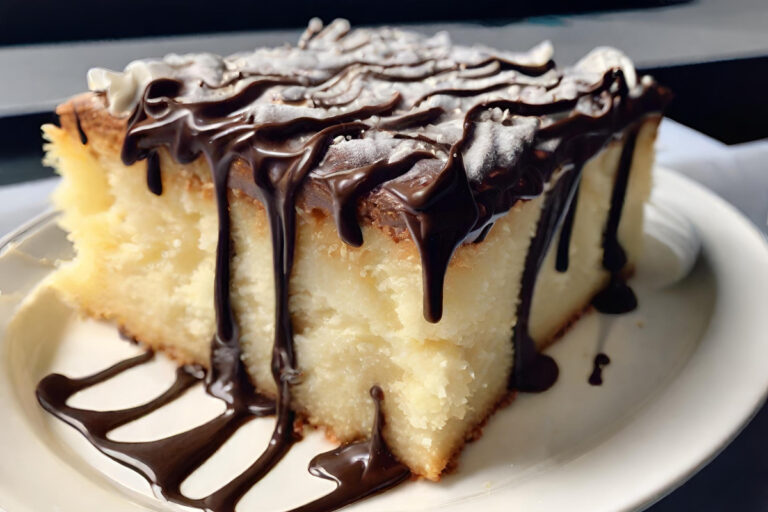Introduction
Butter cake, with its rich flavor and tender crumb, stands as a timeless favorite in the world of desserts. Often overshadowed by more extravagant cakes, the beauty of a classic butter cake lies in its simplicity and the mouthwatering aroma that fills your kitchen as it bakes. This guide will lead you through the essential steps and provide expert tips to ensure your baking butter cake endeavor is a success. Grab your apron, and let’s make baking blissful!
Understanding Butter Cake
What is Butter Cake?
Butter cake is a quintessential dessert, cherished for its rich, buttery flavor and soft, delicate texture. Originating from the basic principles of creaming butter and sugar, this cake forms the foundation for many variations in the baking world. It’s the simplicity and the rich flavor profile that often makes butter cake a go-to recipe for both casual and celebratory settings.
Differences Between Butter Cake and Other Cakes
Unlike its denser cousin, the pound cake, butter cake boasts a lighter, airier texture due to the inclusion of baking powder or baking soda, which acts as a leavening agent. This key distinction sets it apart from the traditional pound cake, which relies solely on eggs for leavening. Additionally, butter cakes offer more versatility in terms of moisture and flavor enhancements, such as the addition of vanilla extract or citrus zest, making each baking experience unique.
Serving and Storage
How to Serve Butter Cake
The presentation of your butter cake can make it even more inviting. Here are some tips for serving:
- Dusting with Powdered Sugar: A light dusting of powdered sugar just before serving adds a touch of elegance and sweetness.
- Add Fresh Fruit: Top slices with fresh berries or a dollop of whipped cream for a fresh contrast to the rich cake.
- Warm Slices: Gently warm slices in the microwave for a few seconds before serving to enhance the buttery flavor and soft texture.
Storage Tips
To preserve the texture and freshness, proper storage is essential:
- Room Temperature: Store the cake in an airtight container at room temperature for up to three days. Ensure it’s covered to prevent drying out.
- Refrigeration: For longer storage, keep the cake in the refrigerator. Wrap it tightly in plastic wrap to maintain moisture, and it can last up to a week.
- Freezing: For long-term storage, wrap the cake well in plastic wrap and then in foil. Freeze for up to three months. Thaw in the refrigerator overnight before bringing to room temperature to serve.
By following these storage tips, you can enjoy your butter cake for days or even weeks after baking, ensuring that none of your delicious efforts go to waste.
Seasonal Adaptations
Embracing the changing seasons with your butter cake baking can add a delightful twist to this classic dessert. Each season offers unique flavors that can be incorporated into your cake, making it a versatile treat that adjusts to the time of year. Here’s how you can adapt your butter cake recipe to fit the seasonal festivities:
Spring Flavors
Spring calls for light and fresh flavors. Infuse your butter cake with lemon zest or incorporate a strawberry compote filling. These ingredients not only add a refreshing taste but also echo the blossoming nature of spring.
Summer Celebrations
During the hot summer months, try adding tropical flavors to your butter cake. Mango puree, coconut flakes, or a passion fruit drizzle can transport your taste buds to a tropical paradise, making it a perfect dessert for summer barbecues or beach parties.
Autumn Warmth
Autumn is all about warm spices and harvest fruits. Mix in spices like cinnamon, nutmeg, or clove to give your cake an autumnal feel. Alternatively, fold diced apples or pears into the batter before baking for a fruity, seasonal twist.
Winter Comfort
In the cold winter months, rich flavors like chocolate or coffee make the cake feel more indulgent. Adding a mocha swirl or topping the cake with a rich chocolate ganache can turn it into a comforting treat, ideal for enjoying beside a warm fireplace.
These seasonal adaptations not only enhance the flavor of your butter cake but also tie it beautifully to the seasonal activities and celebrations, making each slice perfectly timed with the calendar.
Tips for Perfect Frostings and Toppings
A beautifully frosted butter cake can transform it from a simple baked good into a stunning centerpiece. Whether you prefer a light glaze or a rich buttercream, mastering the art of frosting and toppings can elevate your cake. Here are some expert tips to help you perfect your frostings and toppings:
Achieving Smooth Buttercream
- Ensure Butter is at Room Temperature: For a smooth, easy-to-spread buttercream, make sure your butter is soft but not melted.
- Sift the Sugar: Sifting powdered sugar before adding it to the butter helps prevent lumps and ensures a silky texture.
- Add Flavor Gradually: Incorporate vanilla extract, citrus zest, or other flavorings slowly to taste, adjusting as needed without overwhelming the butter base.
Glazes that Gleam
- Thin Consistency: To achieve a glaze that pours smoothly and sets with a shiny finish, ensure your mixture is thin enough. If it’s too thick, add a little more liquid (like milk or lemon juice) until you get the desired consistency.
- Use a Double Boiler: For chocolate glazes, melting chocolate over a double boiler can prevent it from seizing and create a smooth, glossy topping.
- Brush on While Warm: Applying glaze while it’s still warm can help it spread evenly and soak slightly into the cake for added moisture.
Creative Toppings
- Fresh Fruit: Top your cake with fresh berries, citrus slices, or pomegranate arils for a burst of color and freshness.
- Toasted Nuts: Sprinkle chopped, toasted nuts like almonds, pecans, or walnuts for a crunchy texture and nutty flavor.
- Edible Flowers: For a decorative touch, edible flowers such as violets, marigolds, or rose petals can add elegance and a hint of floral taste.
Setting Your Decorations
- Chill Your Cake: Before applying any heavy toppings or intricate designs, chill your cake so the frosting sets. This helps prevent the toppings from sinking into the frosting.
- Plan Your Design: Sketch out your decoration plan beforehand or use a cake turntable for even application.
What Makes a Butter Cake Different from a Sponge Cake?
Butter cake and sponge cake differ primarily in texture and ingredients. Butter cake is denser and richer, using butter as a key ingredient, which imparts a moist, tender crumb. Sponge cake, on the other hand, relies more on beaten eggs to provide volume and has a lighter, airier texture.
Can I Make Butter Cake Without Eggs?
Yes, it’s possible to make an egg-free butter cake. You can use commercial egg replacers, applesauce, or mashed bananas as alternatives. These substitutes aid in binding the ingredients together, however the texture may differ slightly from recipes that follow tradition.
How Can I Ensure My Butter Cake Is Moist?
Do not overbake your butter cake if you want it to stay moist. Overbaking can dry out the cake. Additionally, adding a tablespoon of plain yogurt or sour cream to your batter can help achieve a moist texture. Ensuring your ingredients, especially butter and eggs, are at room temperature before mixing can also help maintain a rich, moist crumb.</p>
Can Butter Cake Be Made in Advance?
Absolut ely! Butter cake tastes better the next day as the flavors have more time to meld together. Just ensure it’s stored properly, covered in an airtight container at room temperature, to maintain its freshness and moisture.
These frequently asked questions address common concerns and tips for perfecting your butter cake, helping you bake with confidence and creativity. Enjoy the process and the delicious outcomes!



